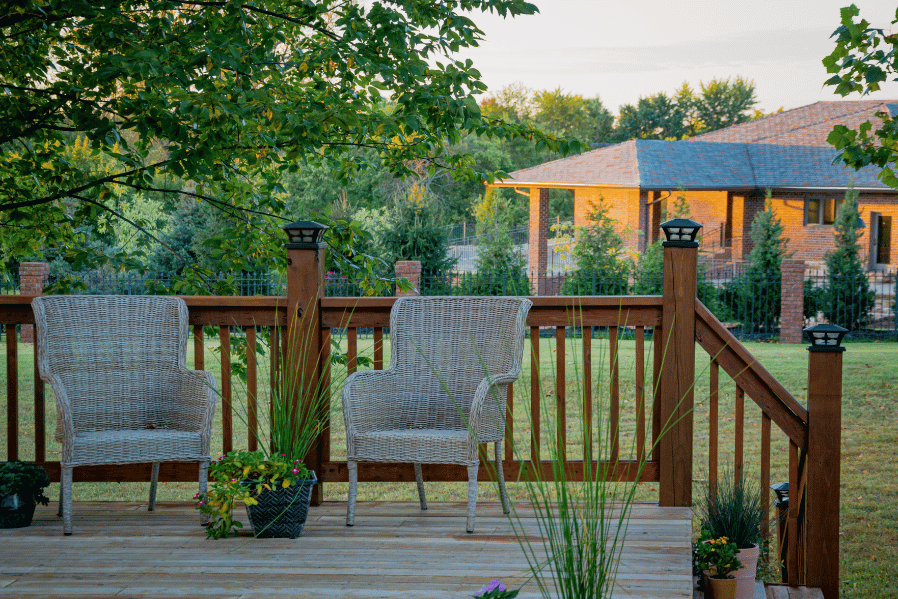How to Choose the Best Decking Materials for Your Deck Remodel
Jul 15th 2024
Your deck is more than a simple outside space; it is a gorgeous extension of your style. Choosing the proper decking material increases not only the visual appeal but also the usefulness and durability of your deck. Imagine how amazing it would be to have a deck that perfectly complements your style and practical needs!
So, before diving into your next deck remodeling project, explore the options available and decide to fit your vision.

4 Factors to Consider When Choosing Decking Materials
When embarking on the journey of selecting the ideal decking material for your deck remodel, there are a ton of factors to weigh. Your top considerations should be:
1) Durability
Assess how well the material withstands water damage, warping, and rotting. Consider the material's ability to resist fading and maintain its color under prolonged sun exposure. High durability is essential for a long-lasting deck, especially in areas with extreme weather conditions. For instance, composite decking materials are known for their resistance to moisture and decay, making them an excellent choice for regions prone to heavy rainfall.
Pressure-treated wood, on the other hand, offers enhanced resistance to rot and insect damage but may require more maintenance over time to keep it in prime condition. Opting for durable materials ensures your deck remains safe and aesthetically pleasing for years to come.
2) Workability
When considering workability in decking materials, evaluate whether the material allows for easy installation, cutting, and shaping. Workability impacts not only the ease of installation but also the flexibility in design. For example, wood decking materials like cedar and redwood are relatively easy to saw and nail, making them ideal for DIY projects.
Composite materials, although durable, may require specialized tools and techniques for installation, potentially increasing labor costs if you're hiring a professional. Choosing materials that are easy to work with can significantly reduce installation time and effort, allowing for more intricate and customized deck designs.
3) Pest Control
Find out if the material is naturally resistant to wood-boring insects and pests. Materials like cedar are known for their bug-resistant properties. Pest control is a critical consideration, particularly in areas where termites and other wood-destroying insects are prevalent.
Treated lumber and composite decking offer excellent resistance to pests, reducing the risk of damage and the need for chemical treatments. Natural woods like teak and ipe are also renowned for their pest-resistant qualities, providing a durable and eco-friendly option. Selecting pest-resistant materials can prevent costly repairs and extend the lifespan of your deck.
4) Cost
Undoubtedly, cost plays a crucial role in the decision-making process for many homeowners. While setting a budget for your deck remodeling is essential, it is equally important to understand the overall cost implications associated with different decking materials. Initial costs, long-term maintenance expenses, and potential repairs should all be factored into your budget.
For instance, while pressure-treated wood is generally more affordable upfront, it may require frequent staining and sealing. Composite decking, though more expensive initially, tends to have lower maintenance costs over its lifespan. Balancing upfront costs with long-term value ensures you make a financially sound decision for your deck remodel.

Top 3 Types of Decking Materials
There's no shortage of options for selecting materials to cater to diverse styles and requirements. From traditional wood to cutting-edge composite materials, the possibilities are vast. Let's explore some of the most common materials for your deck wrecker tool below:
1) Natural Wood
Decks can use different types of softwoods and hardwoods. There's something about the authenticity and charm of wood that never goes out of style.
Hardwood species are exceptionally durable and resistant to wear and tear. They have high density and natural oils that make them resistant to rot, decay, and insect infestation. Their beautiful grain patterns and rich colors add elegance to any deck.
Regarding cost and ease of use, hardwoods may come at a higher price and require more effort due to their dense nature. On the contrary, homeowners on a budget favor softwoods like pine and cedar as they offer an affordable solution. They are easier to work with because of their lower density. This wood type may require more frequent maintenance.
The average lifespan of wood decks is around ten years before they require significant repairs or replacement.
Pros and Cons of Natural Wood
| Pros | Cons |
| The natural appeal of wood decking creates a welcoming outdoor space | Wood decks require regular maintenance else they will crack or fade |
| An eco-friendly option when sourced responsibly | Hardwood decking can be quite expensive, and the cost of maintenance materials and labor should be factored in over the deck's lifespan |
2) Composite Decking
One of the most appealing features of composite decking is its low maintenance requirements. Unlike wood decks that demand regular staining, sealing, and sanding, composite decking only needs periodic cleaning to maintain its appearance.
It is a blend of wood flour and polymer decking materials. The composition may vary among manufacturers, but it typically includes the following components:
Wood Fibers: Composite decking is stronger with recycled wood fibers such as sawdust or wood chips.
Plastic: High-density polyethylene (HDPE) or polyvinyl chloride (PVC) commonly appear in plastics that help bind the composite materials together and provide resistance against moisture and rot.
Additives: Various additives such as UV inhibitors and stabilizers are incorporated into the composite mixture to enhance performance.
A composite deck can often last for more than 20 years!
Pros and Cons of Composite Decks
| Pros | Cons |
| It is engineered to endure the most severe weather conditions | Composite decking has a slightly higher initial cost. However, the long-term savings in maintenance and replacement costs can offset this initial investment. |
| Composite decking has a significantly longer lifespan compared to natural wood | In hot climates, composite decking retains more heat than natural wood |
3) Pressure-Treated Wood
Although a versatile and widely used building material, wood has inherent vulnerabilities that can affect its lifespan. The pressure treatment method effectively mitigates these weaknesses, providing a solution that enhances the wood's strength and resistance.
The process involves placing the wood in a pressure chamber and injecting chemical preservatives into the wood fibers under high pressure. Preservatives used are usually chemicals like copper azole and micronized copper quaternary. Pressure treatment ensures that the preservatives penetrate deeply into the wood, providing long-lasting decking materials.
Pros and Cons of Pressure Treated Wood
| Pros | Cons |
| Lower costs as opposed to other wood decking materials | It requires regular maintenance to prolong its lifespan |
| Resists rot, repels moisture, and deters insects | Higher expenses for repairs in the future |
Other Decking Materials
There are more options than just natural wood and composite decking. PVC decking, fiberglass decking, HDPE decking, and aluminum decking are some alternative materials that you can consider.

Top Deck Removal Tools for Projects
If you are planning a deck removal project, having the necessary deck demo tools can make the entire process much more efficient. Here are some essential tools you will need to get the job done right:
Heavy-Duty Hammer: Useful for removing nails, pounding out damaged boards, or breaking apart stubborn connections.
Screwdriver: Essential for removing screws or fasteners.
Pallet Breaker: A pallet breaker or pallet buster is ideal for prying up and removing deck boards and dismantling pallets. The Wrecking Claw provides excellent leverage, making the deck removal process quicker and easier.
Key Takeaways
All of these decking materials have distinct qualities, such as price, upkeep demands, visual appeal, etc. You should choose the right solution for your eck by weighing these options and using a Wrecking Claw deck wrecker tool to make your project easier.
With careful consideration of the key points highlighted in this article and an assessment of your project's unique requirements, you can confidently select the decking material that best suits your needs.
The #1 Pallet Removal Tool
If you're in search of the perfect tool for pallet demolition, look no further than the Angel-GUARD Wrecking Claw. As a versatile pallet breakdown tool and deck board removal tool, it enhances the efficiency of your projects. With its focus on safety, speed, and efficient fastener removal, the Wrecking Claw simplifies the process of dismantling wooden pallets and removing deck boards.
Upgrade your Pallet Removal Experience with the Angel-GUARD Wrecking Claw and witness the ease and effectiveness it brings to your deck wrecker tasks.
Follow us on Instagram for exclusive decking tips and product offers!


